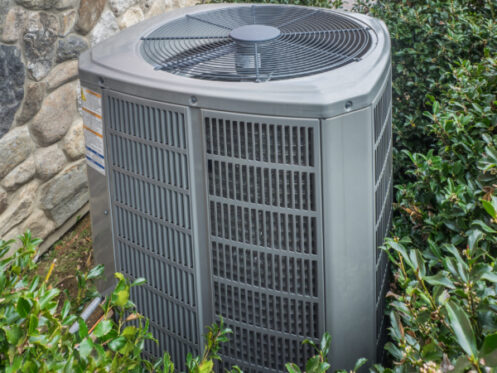All heat pumps have a defrost cycle that is designed to ensure the unit doesn’t freeze up when it is heating in cold weather. The way that heat pumps provide heat is by using cold liquid refrigerant to capture heat energy from the air outside the home. This process turns the refrigerant from a cold liquid into a warm gas, and the refrigerant then goes through an expansion valve that instantly turns it into a hot gas. Finally, the refrigerant flows into the indoor coil where all of the stored energy is released into the air flowing over the coil.
The refrigerant that flows through the coil in the outdoor unit is quite cold. As it absorbs heat, moisture in the air always begins to condense on the coil, and this can quickly lead to ice starting to form inside the unit whenever the outdoor air temperature is below freezing. This is where the unit’s defrost cycle comes in as it works to melt any ice to prevent the unit from freezing up. Here is everything you need to know about heat pump defrost cycles, how it works and why it is so important.
How a Heat Pump’s Defrost Cycle Works
Heat pumps are quite similar to central air conditioners as both units cool in exactly the same way. The difference is that heat pumps have something known as a reversing valve that allows them to reverse the direction that the refrigerant flows so the unit can then absorb heat from the air outside and use it to heat the air inside the building.
When a heat pump needs to defrost, all it does is temporarily switch over to cooling mode. This means that the reversing valve activates and the refrigerant starts flowing in the opposite direction. Instead of cold refrigerant flowing through the outdoor coil as it normally does when the unit is heating, it switches so that refrigerant flows from inside the home and then through the outdoor coil to thaw any frost and ice.
The way it works is that the refrigerant flows into the outdoor unit and through its compressor. The compressor greatly increases the pressure of the refrigerant so that it transforms into an extremely hot gas, and this gas then flows through the coil to help it thaw out. For the process to work properly, the fan in the outdoor heat pump unit always shuts off whenever defrosting. This is important as moisture would condense on the coil if the fan continued to run, which would lead to more frost forming and prevent the coil from properly thawing out.
Whenever a heat pump defrosts, it temporarily stops producing any heat. This usually isn’t an issue in Texas since the weather typically never gets cold enough that you would need to worry about not having heat for a few minutes.
However, most homes that rely on a heat pump for heating still require a secondary heat source like an electric resistance heater. This auxiliary source will automatically kick on whenever the heat pump defrosts to prevent the house from quickly becoming too cold. The main reason that this secondary heat source is necessary is that the indoor blower still has to run when the heat pump defrosts, and this would lead to cold air blowing out of the vents if there wasn’t a secondary heat source.
When defrosting, the blower works to circulate warm air over the indoor coil. This is important as the refrigerant that flows through the indoor coil when the heat pump is defrosting is quite cold. This means that the indoor coil would quickly start to freeze up if the blower didn’t continue to run when the system was defrosting.
If the indoor coil ever were to freeze, it would lead to liquid refrigerant flowing into the heat pump compressor. The refrigerant always has to be a gas when it enters the compressor. If liquid refrigerant flows into the compressor, it will get inside the unit’s crankcase and settle below the oil in the crankcase. The refrigerant then starts to boil off and causes some of the oil to vaporize as well. This leads to the oil level quickly dropping to where the motor can’t stay properly lubricated and will quickly start to burn out.
A burnt-out compressor motor is the absolute last thing you want to happen. In most cases, your only option in this situation is to install a new heat pump as replacing the compressor motor is often as much or more expensive than installing a whole new unit.
How Often Does a Heat Pump Need to Defrost?
In colder climates, a heat pump will often need to defrost at least once an hour. However, the fact that the Dallas area rarely ever sees temperatures below freezing means that your heat pump may never need to defrost.
This is because heat pumps only ever defrost when they detect that the temperature of the coil in the outdoor unit drops below 32 degrees. Whenever this happens, the unit will then switch over to the defrost cycle and continue to defrost until the coil temperature reaches approximately 57 degrees. Once the unit is sufficiently warm, it will switch back over and start heating as normal.
The exact length of the defrost cycle can vary quite a bit depending on how much frost has formed on the coil and the outdoor air temperature. The defrost cycle may only last for a few minutes at most in temperatures just below freezing, but it sometimes takes up to 15 minutes in extremely cold weather.
What to Do If Your Heat Pump Won’t Defrost
If a heat pump doesn’t defrost and too much frost collects on the outdoor coil, cold refrigerant will start flowing inside. This will quickly lead to your system blowing cold air out of your vents. If you do ever notice cold air coming out of your vents when you can hear your heat pump running, you should immediately shut the system off at your thermostat to prevent possible damage to the compressor motor. Once it is off, you will then want to go outside and look inside the heat pump to see if there is frost on the coil. If there is frost, you’ll want to leave the system off until you can have a technician inspect your heat pump.
The most common reason that a heat pump won’t be able to defrost is due to an issue with the unit’s reversing valve. The valve can sometimes get stuck in one position, and it can also leak or simply break and prevent the unit from defrosting. Heat pumps can also fail to defrost due to an issue with the compressor. In either case, you will need to have a technician inspect the unit to determine what the problem is and how to repair it.
If your heat pump won’t defrost or has any other issues, you can count on the team at Dring Air Conditioning & Heating for help. We work on all brands of heat pumps as well as furnaces and air conditioners, and we offer 24/7 same-day emergency repairs in Carrollton and throughout the Dallas area. Our team can also assist with heating and cooling maintenance or if you need a new HVAC unit installed. For more information, contact Dring Air Conditioning & Heating today.







